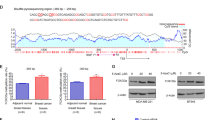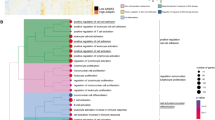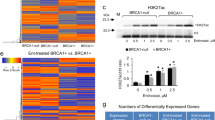Abstract
DNA-hypermethylation of SOCS genes in breast, ovarian, squamous cell and hepatocellular carcinoma has led to speculation that silencing of SOCS1 and SOCS3 genes might promote oncogenic transformation of epithelial tissues. To examine whether transcriptional silencing of SOCS genes is a common feature of human carcinoma, we have investigated regulation of SOCS genes expression by IFNγ, IGF-1 and ionizing radiation, in a normal human mammary epithelial cell line (AG11134), two breast-cancer cell lines (MCF-7, HCC1937) and three prostate cancer cell lines. Compared to normal breast cells, we observe a high level constitutive expression of SOCS2, SOCS3, SOCS5, SOCS6, SOCS7, CIS and/or SOCS1 genes in the human cancer cells. In MCF-7 and HCC1937 breast-cancer cells, transcription of SOCS1 is dramatically up-regulated by IFNγ and/or ionizing-radiation while SOCS3 is transiently down-regulated by IFNγ and IGF-1, suggesting that SOCS genes are not silenced in these cells by the epigenetic mechanism of DNA-hypermethylation. We further show that the kinetics of SOCS1-mediated feedback inhibition of IFNγ signaling is comparable to normal breast cells, indicating that the SOCS1 protein in breast-cancer cells is functional. We provide direct evidence that STAT3 pathways are constitutively activated in MCF-7 and HCC1937 cells and may drive the aberrant persistent activation of SOCS genes in breast-cancer cells. Our data therefore suggest that elevated expression of SOCS genes is a specific lesion of breast-cancer cells that may confer resistance to proinflammatory cytokines and trophic factors, by shutting down STAT1/STAT5 signaling that mediate essential functions in the mammary gland.
This is a preview of subscription content, access via your institution
Access options
Subscribe to this journal
Receive 50 print issues and online access
$259.00 per year
only $5.18 per issue
Buy this article
- Purchase on Springer Link
- Instant access to full article PDF
Prices may be subject to local taxes which are calculated during checkout





Similar content being viewed by others
References
Andrews HN, Mullan PB, McWilliams S, Sebelova S, Quinn JE, Gilmore PM et al. (2002). BRCA1 regulates the interferon gamma-mediated apoptotic response. J Biol Chem 277: 26225–26232.
Aprelikova O, Pace AJ, Fang B, Koller BH, Liu ET . (2001). BRCA1 is a selective co-activator of 14-3-3 sigma gene-transcription in mouse embryonic-stem cells. J Biol Chem 276: 25647–25650.
Bowman T, Garcia R, Turkson J, Jove R . (2000). STATs in oncogenesis. Oncogene 19: 2474–2488.
Brender C, Lovato P, Sommer VH, Woetmann A, Mathiesen AM, Geisler C et al. (2005). Constitutive SOCS-3 expression protects T-cell lymphoma against growth-inhibition by IFNalpha. Leukemia 19: 209–213.
Campbell IL . (2005). Cytokine-mediated inflammation, tumorigenesis, and disease-associated JAK/STAT/SOCS signaling circuits in the CNS. Brain Res Brain Res Rev 48: 166–177.
Catteau A, Morris JR . (2002). BRCA1 methylation: a significant role in tumour development? Semin Cancer Biol 12: 359–371.
Clevenger CV . (2004). Roles and regulation of stat family transcription factors in human breast cancer. Am J Pathol 165: 1449–1460.
Coccia EM, Del-Russo N, Stellacci E, Orsatti R, Benedetti E, Marziali G et al. (1999). Activation and repression of the 2-5A synthetase and p21 gene promoters by IRF-1 and IRF-2. Oncogene 18: 2129–2137.
Cui JQ, Shao N, Chai Y, Wang H, Reddy ES, Rao VN . (1998). BRCA1 splice variants BRCA1a and BRCA1b associate with CBP co-activator. Oncol Rep 5: 591–595.
Darnell Jr JE . (1997). STATs and gene regulation. Science 277: 1630–1635.
Darnell JE . (2005). Validating Stat3 in cancer therapy. Nat Med 11: 595–596.
Gritsko T, Williams A, Turkson J, Kaneko S, Bowman T, Huang M et al. (2006). Persistent activation of stat3 signaling induces survivin gene expression and confers resistance to apoptosis in human breast cancer cells. Clin Cancer Res 12: 11–19.
Haura EB, Turkson J, Jove R . (2005). Mechanisms of disease: Insights into the emerging role of signal transducers and activators of transcription in cancer. Nat Clin Pract Oncol 2: 315–324.
He B, You L, Uematsu K, Zang K, Xu Z, Lee AY et al. (2003). SOCS-3 is frequently silenced by hypermethylation and suppresses cell growth in human lung cancer. Proc Natl Acad Sci USA 100: 14133–14138.
Hilton DJ . (1999). Negative regulators of cytokine signal transduction. Cell Mol Life Sci 55: 1568–1577.
Issa JP . (2004). CpG island methylator phenotype in cancer. Nat Rev Cancer 4: 988–993.
Le Provost F, Miyoshi K, Vilotte JL, Bierie B, Robinson GW, Hennighausen L . (2005). SOCS3 promotes apoptosis of mammary differentiated cells. Biochem Biophys Res Commun 338: 1696–1701.
Medina D . (2005). Mammary developmental fate and breast cancer risk. Endocr Relat Cancer 12: 483–495.
Missiaglia E, Donadelli M, Palmieri M, Crnogorac-Jurcevic T, Scarpa A, Lemoine NR . (2005). Growth delay of human pancreatic-cancer-cells by methylase inhibitor 5-aza-2′-deoxycytidine-treatment is associated with activation of the interferon signalling pathway. Oncogene 24: 199–211.
Niwa Y, Kanda H, Shikauchi Y, Saiura A, Matsubara K, Kitagawa T et al. (2005). Methylation-silencing of SOCS-3 promotes cell growth and migration by enhancing JAK/STAT and FAK-signalings in human hepatocellular carcinoma. Oncogene 24: 6406–6417.
Ouchi T, Lee SW, Ouchi M, Aaronson SA, Horvath CM . (2000). Collaboration of signal transducer and activator of transcription-1 (STAT1) and BRCA1 in differential-regulation of IFN-gamma target genes. Proc Natl Acad Sci USA 97: 5208–5213.
Raccurt M, Tam SP, Lau P, Mertani HC, Lambert A, Garcia-Caballero T et al. (2003). Suppressor of cytokine-signalling gene expression is elevated in breast-carcinoma. Br J Cancer 89: 524–532.
Rottapel R, Ilangumaran S, Neale C, La-Rose J, Ho JM, Nguyen MH et al. (2002). The tumor suppressor activity of SOCS-1. Oncogene 21: 4351–4362.
Saito H, Morita Y, Fujimoto M, Narazaki M, Naka T, Kishimoto T . (2000). IFN regulatory factor-1-mediated transcriptional activation of mouse STAT-induced STAT inhibitor-1 gene promoter by IFN-gamma. J Immunol 164: 5833–5843.
Sultan AS, Xie J, LeBaron MJ, Ealley EL, Nevalainen MT, Rui H . (2005). Stat5 promotes homotypic adhesion and inhibits invasive characteristics of human breast-cancer cells. Oncogene 24: 746–760.
Sutherland KD, Lindeman GJ, Choong DY, Wittlin S, Brentzell L, Phillips W et al. (2004). Differential hypermethylation of SOCS genes in ovarian and breast-carcinomas. Oncogene 23: 7726–7733.
Tanaka N, Ishihara M, Lamphier MS, Nozawa H, Matsuyama T, Mak TW et al. (1996). Cooperation of the tumour suppressors IRF-1 and p53 in response to DNA damage. Nature 382: 816–818.
Teodoridis JM, Hall J, Marsh S, Kannall HD, Smyth C, Curto J et al. (2005). CpG-island methylation of DNA damage response genes in advanced ovarian cancer. Cancer Res 65: 8961–8967.
Toyota M, Ahuja N, Ohe-Toyota M, Herman JG, Baylin SB, Issa JP . (1999). CpG-island methylator phenotype in colorectal cancer. Proc Natl Acad Sci USA 96: 8681–8686.
Weber A, Hengge UR, Bardenheuer W, Tischoff I, Sommerer F, Markwarth A et al. (2005). SOCS-3 is frequently methylated in head and neck squamous-cell carcinoma and its precursor lesions and causes growth inhibition. Oncogene 24: 6699–6708.
Wei M, Grushko TA, Dignam J, Hagos F, Nanda R, Sveen L et al. (2005). BRCA1 promoter methylation in sporadic breast cancer is associated with reduced BRCA1 copy-number and chromosome-17 aneusomy. Cancer Res 65: 10692–10699.
Welcsh PL, Lee MK, Gonzalez-Hernandez RM, Black DJ, Mahadevappa M, Swisher EM et al. (2002). BRCA1 transcriptionally regulates genes involved in breast tumorigenesis. Proc Natl Acad Sci USA 99: 7560–7565.
Yu CR, Mahdi RM, Ebong S, Vistica BP, Chen J, Guo Y et al. (2004). Cell proliferation and STAT6 pathways are negatively-regulated in T-cells by STAT1 and suppressors of cytokine-signaling. J Immunol 173: 737–746.
Acknowledgements
This research was funded by the Intramural Research Programs of the NIH, NIA and NEI. Authors thank Dr Simon Nyaga for technical assistance and critical reading of manuscript and Dr Patrice Morin for critical reading of the manuscript.
Author information
Authors and Affiliations
Corresponding author
Additional information
Supplementary Information accompanies the paper on the Oncogene website (http://www.nature.com/onc).
Supplementary information
Rights and permissions
About this article
Cite this article
Evans, M., Yu, CR., Lohani, A. et al. Expression of SOCS1 and SOCS3 genes is differentially regulated in breast cancer cells in response to proinflammatory cytokine and growth factor signals. Oncogene 26, 1941–1948 (2007). https://doi.org/10.1038/sj.onc.1209993
Received:
Revised:
Accepted:
Published:
Issue Date:
DOI: https://doi.org/10.1038/sj.onc.1209993
Keywords
This article is cited by
-
The importance of SOCS1 − 1478 CA/del polymorphism and expression in breast cancer: a case–control study in the north of Iran
Breast Cancer Research and Treatment (2023)
-
SOCS5 inhibition induces autophagy to impair metastasis in hepatocellular carcinoma cells via the PI3K/Akt/mTOR pathway
Cell Death & Disease (2019)
-
Suppressor of cytokine signaling (SOCS) genes are downregulated in breast cancer
World Journal of Surgical Oncology (2018)
-
The Expression Levels of IL-4/IL-13/STAT6 Signaling Pathway Genes and SOCS3 Could Help to Differentiate the Histopathological Subtypes of Non-Small Cell Lung Carcinoma
Molecular Diagnosis & Therapy (2018)
-
CD8+ T cells promote proliferation of benign prostatic hyperplasia epithelial cells under low androgen level via modulation of CCL5/STAT5/CCND1 signaling pathway
Scientific Reports (2017)



